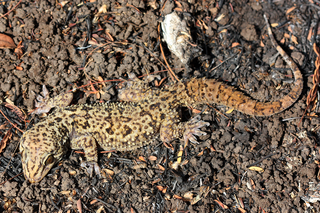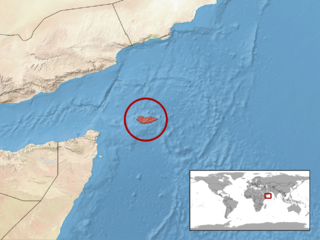
Hemidactylus is a genus of the common gecko family, Gekkonidae. It has 168 described species, newfound ones being described every few years. These geckos are found in all the tropical regions of the world, extending into the subtropical parts of Africa and Europe. They excel in colonizing oceanic islands by rafting on flotsam, and are for example found across most of Polynesia. In some archipelagoes, cryptic species complexes are found. Geckos like to live in and out of houses. They have been introduced to Australia.

Hemidactylus brookii, commonly known as Brooke's house gecko or spotted house gecko, is a widespread species of gecko.

The Indo-Pacific gecko also known as Garnot's house gecko, the fox gecko, or the Assam greyish brown gecko, is a species of gecko found in India, the Philippines, Southeast Asia, Australia, and throughout Polynesia. Adults are about 4 to 5 in in total length. They are seen as dark gray or brown with light markings in daylight and a pale, translucent colour at night. The belly is orange or yellow. The head has a long, narrow snout, hence the name fox gecko. The flattened tail has a row of spiny scales on the lateral edges. The species is parthenogenic – all individuals are female and lay eggs that hatch without requiring male fertilisation.

Hemidactylus maculatus, also known as the spotted leaf-toed gecko or giant spotted gecko, is a species of large gecko found in the Western Ghats of India and in parts of Sri Lanka.

The Mediterranean house gecko is a type of house gecko common to the Mediterranean area which has spread to many parts of the world. It is commonly referred to as the Turkish gecko as represented in its Latin name and also as the moon lizard because it emerges in the evening.

The tropical house gecko, Afro-American house gecko or cosmopolitan house gecko is a species of house gecko native to sub-Saharan Africa. It is also currently found in North, Central and South America and the Caribbean, where it has been inadvertently introduced by humans.

The common house gecko, is a gecko native to Southeast Asia. It is also known as the Asian house gecko, Pacific house gecko, wall gecko, house lizard, or moon lizard.

Hemidactylus depressus, also known as Sri Lanka leaf-nosed gecko or Kandyan gecko, is a species of gecko endemic to island of Sri Lanka.
The spotted giant gecko is a species of gecko endemic to island of Sri Lanka.
Hemidactylus mandebensis is a species of house gecko from Yemen. It grows to 42 mm (1.7 in) in snout–vent length. It is a relatively small-sized member of the Hemidactylus robustus species group.
Hemidactylus graniticolus is a cryptic rock-dwelling species of large gecko found in India. The holotype was described from hills near Harohalli village in the Bangalore Rural District, Karnataka.

The Socotran rock gecko is a species of gecko. It is endemic to Socotra.
The Meghamalai rock gecko is a species of gecko. It is endemic to Tamil Nadu in India.
Treutler's gecko is a species of lizard in the family Gekkonidae. The species is endemic to India.
The Kanker rock gecko is a species of gecko. It is endemic to Chhattisgarh, India.
Hemidactylus siva, also known as the Hampi rock gecko, is a species of house gecko from India.
Hemidactylus kolliensis, the Kolli rock gecko is a species of gecko. It is endemic to India.







